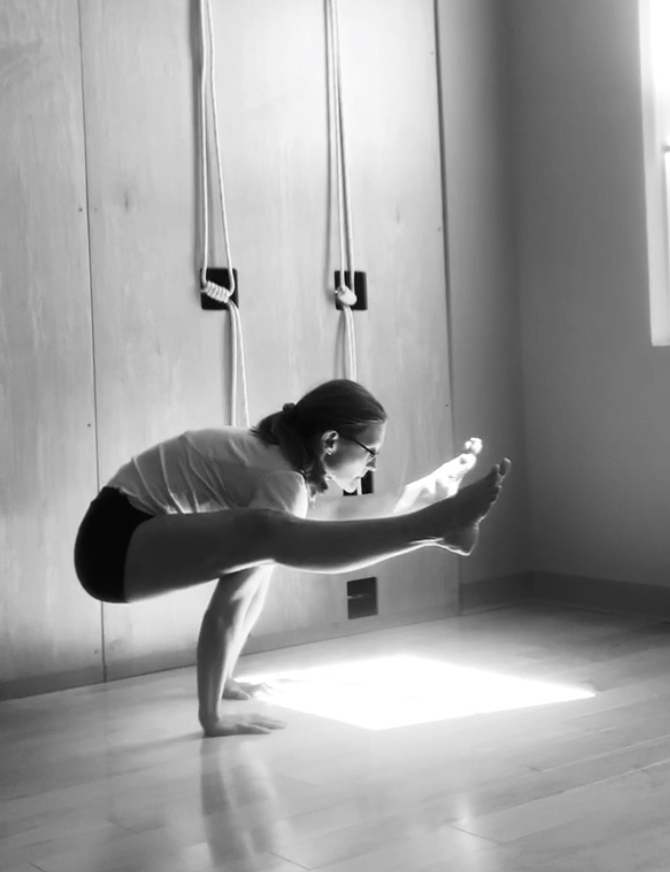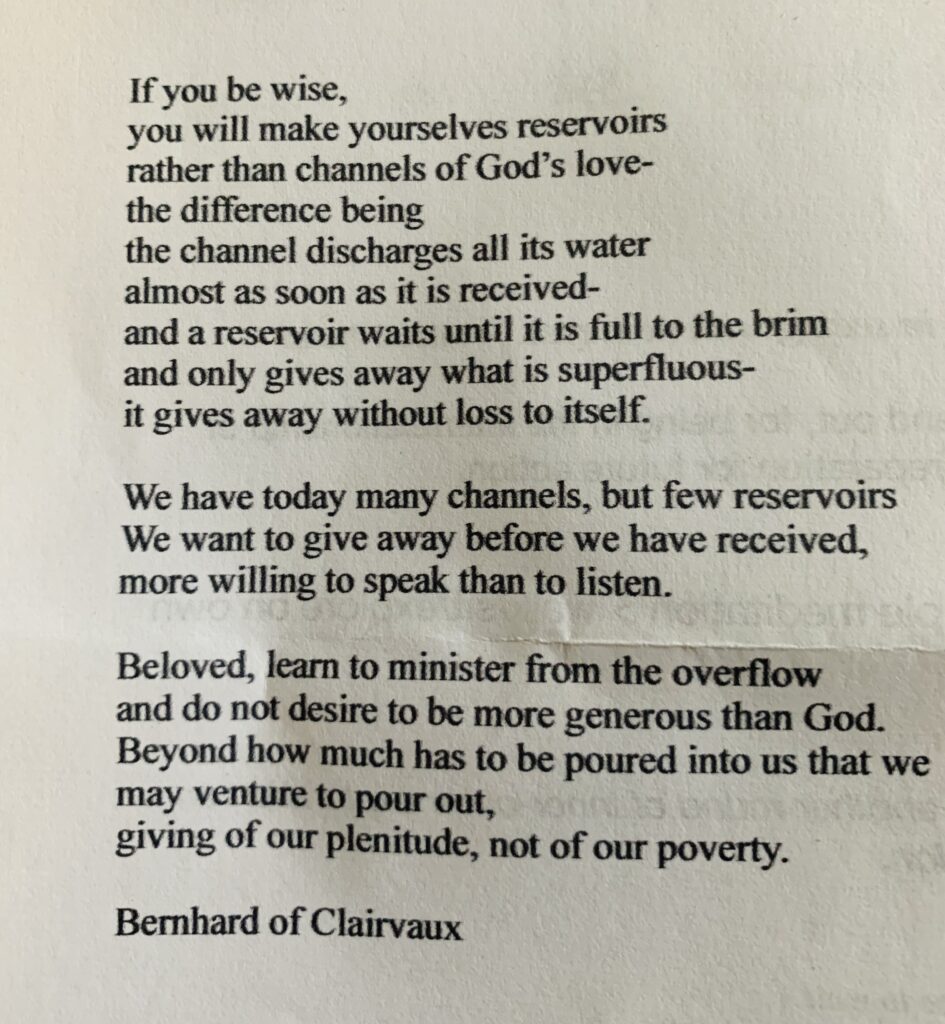To live demands that we make decisions on how to act, and what to do. B. K. S. Iyengar asks, “How does a freeman act, and yet remain free?” (B. K. S. Iyengar, 2005, p. 238). Patanjali’s Yoga Sutras seek to answer this question by exploring the “Klesas” (afflictions) which are the motivations that drive our actions. Through practice we can become aware of our habit patterns, act skillfully and directly, and find freedom in the life of daily routine.
The five kleśas or afflictions appear as psychological “somato-psychic” conditions (B. K. S. Iyengar, 2012 pg. 82). The primary motivation of the kleśas is the desire to preserve the ego-self. 2.3 Avidyᾱ asmitᾱ-rᾱga-dveṣa abinveśaḥ-kleśᾱḥ lists the kleśas. The second is asmitᾱ – the ego identity. Asmitᾱ is formed to protect the identity we show to the world. To do this, asmitᾱ seeks out more of, and becomes attached to, what gives pleasure and security. This is raga, the third kleśa. Asmitᾱ rejects and avoids what is painful, disturbing, and threatening. This is dveṣa, the fourth kleśa. Asmitᾱ’s preservation techniques have a logic to them as the kleśas offer layers of protection. However, if left unattended asmitᾱ is motivated only to satisfy pleasure and avoid pain. Any challenge to these motivations brings up fear. Prashant writes that we cannot tolerate the “empirical I being tormented or harassed” (P.Iyengar, 2013, p. 33). Fear, and fear of death, is translated as abhiniveśaḥ and is the fifth kleśa. Fear is an instinctive reaction to anything that threatens asmitᾱ, not just in terms of death and dying, but to whatever challenges its continuity. B.K.S. Iyengar writes that abhiniveśaḥ “is instinctive and causes one to become selfish and self-centered” (B. K. S. Iyengar, 2005, p. 105).
Most of us are unaware of our motivations. We even consider our likes, dislikes, and fears to
represent individual freedom of expression. This is avidyᾱ, the first kleśa, meaning ignorance, not knowing, or lack of awareness. Avidyᾱ encompasses all the other kleśas. Avidyᾱ leads to incorrect comprehension of reality. Strangely, avidyᾱ is seldom expressed as avidyᾱ. We rarely find ourselves saying – “I’m so ignorant about this or that”. We are more likely to say, “ I always do it this way” or “I never do it that way”. One of avidyᾱ ’s characteristics is that it is hidden. We notice avidyᾱ “more by its absence than its presence” (Desikachar, 1995, p. 11). Moreover, we may not even have an urge to notice them, let alone lessen their effect, because they are effective at protecting asmitᾱ and, as Desikachar comments, we have little, or no, interest in reducing their effects (Desikachar, 1995). Prashant Iyengar writes that the kleśas are “utterly delicious to the body, mind, senses, like the dessert in the context of the meals of life” (P. Iyengar, 2013, p. 33).
B. K.S. Iyengar emphasizes that the kleśas are not simply obstacles, but “wave patterns of interference that stem from our glorious individuality” (B. K. S. Iyengar, 2005, p. 194) : and yet they are “suffering and the cause of suffering” (Mehta, 1975, p. 108), they are “affliction, pain, distress, sorrow, trouble” (B. K. S. Iyengar, 2005, p. 105). Why? Because they stop us from being present and give us the illusion that we are living in reality, when in fact we are living in a reality built by the kleśas designed to protect asmitᾱ.
Karma means to do, to act, and also the effect, or result of an action. The Bhagavad Gita states, “no-one, even in the twinkling of an eye, ever exists without performing action” (Sargeant, 1984, p. 111).
Sutra 4.7 karma aśukla akṛṣṇam yoginaḥ trividham itareṣᾱm says that “The karma of a yogi is neither good nor bad: in the case of others, karma is of a threefold nature” (Mehta, 1975, p. 405). Edwin Bryant refers to Vyasa’s commentary on Karma (Bryant, 2009) which can be: “Black” consisting of selfish, unkind and destructive acts; “White” actions which are of honesty, austerity, self-study, and non-attachment; and Grey karma, a blend of the two with limitless shades of Black and White. The results from Black karma are negative, White karma are positive or indifferent, and Grey brings about mixed results. Vyasa comments that negative karma, can be from actions that are positive, and negative karma cannot destroy positive karma, but it can merge into grey karma, and therefore “one should aim toward good deeds” (Bryant, 2009, p. 416).
What determines the type of karma we enact are the kleśas. Prashant Iyengar writes that, “all the kleśas have a boiling-bubbling potential for karma” (P. Iyengar, 2013 pg. 121), and that the “kleśas are the roots and sources of karma” (P. Iyengar, 2013 pg. 41). Sutra 2.12 kleśamūlaḥ karmᾱśayaḥ dṛṣta adṛṣṭa janma vedanῑyaḥ states that our birth is determined by past karma, and driven by the kleśas. Sati mule tadvipᾱkaḥ jᾱti ᾱyuḥ bhogᾱḥ (2.13) adds that the quality and duration of our life is determined by our karmic experiences. Sutra 2.14 te hlᾱda paritᾱpa phalᾱḥ puṇya apuṇya hetutvᾱt infers that our current birth is limited by the pleasurable or painful fruits of past and present karma (B. K. S. Iyengar, 2006).
We act from our fears, our desires, and our dislikes to preserve asmitᾱ. The results of our actions cause us to react from the kleśas, causing more karma driven by the kleśas. The accumulation of karma is known as karmasaya. Prashant writes, “Kleśas are materially responsible for our actions, reactions, unactions, nonactions, and responses” (P. Iyengar, 2013, p. 128). Our entire karmic being is present at every moment in the form of habits and tendencies. The word vᾱsanᾱ means subliminal impression or tendency. Sutra 4.8 tataḥ tadvipᾱka anuguṇᾱnᾱm eva abhivyaktiḥ vᾱsanᾱnᾱm explains that vᾱsanᾱs arise and become active under certain conditions. While we might perceive that our next action emanates from an independent decision-making process, it is, in fact, linked to past karma and motivated by the kleśas. We use the phrase “to be stuck in a rut” to mean that we feel compelled to act in the same way repeatedly as if what we do is beyond our control; that we are helpless in the face of our desires, pleasures, aversions, and fears. 4.9 jᾱti deśa kᾱla vyavahitᾱnᾱm apy ᾱnataryaṁ smṛti saṁskᾱryoḥ ekarūpatvᾱt tells that, “due to the uninterrupted close relationship between memory and subliminal impressions, the fruits of actions remain intact from one life to the next” (B. K. S. Iyengar, 2005, p. 239). The one exception is Ῑśvara 1.24 kleśa karma vipᾱka ᾱsayaiḥ aparᾱamṛṣṭaḥ puruṣaviśeṣaḥ Ῑśvaraḥ. Puruṣaviśeṣaḥ refers to a special being that is Ῑśvara, who is unaffected by the kleśas, karma, and the reactions that ensue. But we are not Ῑśvara.
How to begin to overcome the kleśa/karma cycle? Prashant writes, we must “trace the merit of karma in our drives, motives, tendencies, and intentions behind our actions, and influencing this analysis are the kleśas” (P. Iyengar, 2013, p. 147). Vyasa offers the following threefold sequence to eliminate the influence of the kleśas; firstly, to remove the extreme or gross effects is like shaking a cloth, or washing it in water (Bryant, 2009). Sutra 2.2 samᾱdhi bhᾱrvanᾱrthaḥ kleśa tanūkaraṇᾱrthaśca, says that this can be done through the practice of yoga (B. K. S. Iyengar, 2006). The second cleaning has to be more subtle; Vyasa uses the image of beating a cloth against a stone to remove the finer dirt. Sutra 2.10 te pratiprasavaheyᾱḥ sūksmah suggests that subtle afflictions can be minimized and eradicated by a “process of involution” (B. K. S. Iyengar, 2006, p. 111) noted in sutra 2.11 as dhyᾱna (meditation), as it is the “subtlest discipline of yoga” (B. K. S. Iyengar, 2001, p. 123). Sutra 4.6 tatra dhyᾱnajam anᾱśayam – states that “the one born of meditation is without the storehouse of karma” (Bryant, 2009, p. 414).
Meditation can remove the effects of past karma, and its effects become “burnt seeds”, meaning that they cannot propel further action and effect (Bryant, 2009). 4.12 atῑta anᾱgataṁ svarūpataḥ asti adhavadhedᾱt dharmᾱṇyᾱm explains that through meditation “the past and the future is as real as that of the present” (B. K. S. Iyengar, 2005, p. 243). 4.27 tat cchidreṣu pratyayᾱntarᾱṇi-saṁskᾱrebhyaḥ cautions “when there are moments of non-awareness the old tendencies make their appearance once again” (Mehta, 1975, p. 433) and one must be vigilant. The third level of cleaning is for the most subtle dirt and dust, this can only be done by the most accomplished yogi, for the metaphorical cloth is destroyed completely, in other words, when one’s actions are completely free from attachment to results. Mehta’s commentary on sutra 4.29 (prasaṁkhyᾱne api akusῑdasya sarvathᾱ vivekakhyᾱteḥ dharmameghaḥ samᾱdhiḥ) describes this moment as being “when a state of meditation is an end in itself, and not the means for the fulfilment of some other end” (Mehta, 1975, p. 441). This is the moment where complete virtue and wisdom ensue and is termed as dharmameghaḥ samᾱdhi. Finally, at this point, as sutra 4.30 states (tataḥ kleśa karma nivṛttiḥ) there is freedom from karma and its effects, “as if a kite were released in the sky, without a string, to bring it back to earth” (B. K. S. Iyengar, 2005, p. 238) and one has attained kaivalya.
References
Bryant, E. (2009). The Yoga Sūtras of Patañjali: A New Edition, Translation, and Commentary with Insights from the Traditional Commentators. North Point Press.
Desikachar, T. K. V. (1995). The Heart of Yoga: Developing a Personal Practice. Inner Traditions/Bear.
Iyengar, B. K. S. (2001). Astadala Yogamala (Vol. 2). Allied Publishers Private Limited.
Iyengar, B. K. S. (2005). Light on the Yoga Sutras of Patanjali (New edition edition). HarperCollins India.
Iyengar, B. K. S. (2012). Core of the Yoga Sutras: The Definitive Guide to the Philosophy of Yoga. Harper Thorsons.
Iyengar, B. K. S., Evans, J. J., & Abrams, D. (2006). Light on Life: The Yoga Journey to Wholeness, Inner Peace, and Ultimate Freedom (Reprint edition). Rodale Books.
Iyengar, P. (2013). Fundamentals of Patanjali’s Philosophy: Theory of Klesha and Karma. Ramāmaṇi Iyengar Memorial Yoga Institute & YOG.
Mehta, R. (1975). Yoga, the Art of Integration: A Commentary on the Yoga Sutras of Patanjali. The Theosophical Publishing House.
Sargeant, W. (1984). The Bhagavad Gita: Revised Edition. SUNY Press.
Note: All transliterations of the sutra text is taken from (B. K. S. Iyengar, 2005), spelling of Sanskrit is consistent with that text.




